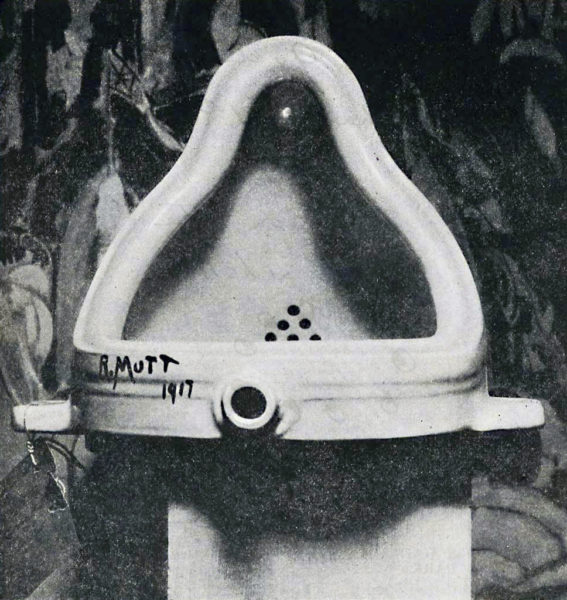 Alfred Stieglitz, Photograph of Marcel Duchamp’s Fountain, 1917, Image in the Public Domain via Wikipedia.
Alfred Stieglitz, Photograph of Marcel Duchamp’s Fountain, 1917, Image in the Public Domain via Wikipedia.
If you feel somewhat alienated by art, or if you find a lot of modern and contemporary art hard to understand, you are not alone. People have been feeling this way for 100 years now, and we all can blame Marcel Duchamp, leader of the Dada movement in American and originator of Conceptual art.
In 1917, Duchamp completely redefined art when he submitted his Readymade sculpture Fountain, a urinal with the inscription “R. Mutt 1917,” to the exhibition of the Society of Independent Artist in New York. Not surprisingly, the piece was rejected by the Society. It didn’t matter; the revolution had begun.
The urinal was art because Duchamp chose it and said it was art. The signature, “R. Mutt” is a play on both JL Mott Ironworks, the company that manufactured the urinal, and part of the popular Mutt and Jeff comic strip duo. Augustus Mutt was known for being rather crude and greedy. Fountain, therefore, was intended to mock American’s reverence for industry in general and plumbing in particular (New York City was known for its terrific plumbing). With this came the birth of Conceptual art, wherein the concept wins out over the aesthetics.
Easily, this is the most influential work of American art from the 20th century. Without Fountain and Conceptual art, we would not have many major art movements from the last century, including Abstract Expressionism and Pop Art. Yet, this is what makes art so inaccessible to many. It is hard to just look at Conceptual art and learn everything you need to know about it.
The emphasis on the concept also happens to be what makes many modern and contemporary works of art so rich and so essential. For example, Fountain effectively communicates the sense of hopelessness felt by Dada artists – the thought that nothing had meaning any longer and humankind was morally bankrupt in the wake of the mass carnage and destruction of the First World War.
All Conceptual art articulates a particular time and place that cannot be efficiently articulated any other way. To learn about Conceptual art is to understand how powerful artistic expression can be in identifying a moment in history as well as the sentiments of those who were living it.
 Alfred Stieglitz, Photograph of Marcel Duchamp’s Fountain, 1917, Image in the Public Domain via Wikipedia.
Alfred Stieglitz, Photograph of Marcel Duchamp’s Fountain, 1917, Image in the Public Domain via Wikipedia.
 Alfred Stieglitz, Photograph of Marcel Duchamp’s Fountain, 1917, Image in the Public Domain via Wikipedia.
Alfred Stieglitz, Photograph of Marcel Duchamp’s Fountain, 1917, Image in the Public Domain via Wikipedia.
 Alfred Stieglitz, Photograph of Marcel Duchamp’s Fountain, 1917, Image in the Public Domain via Wikipedia.
Alfred Stieglitz, Photograph of Marcel Duchamp’s Fountain, 1917, Image in the Public Domain via Wikipedia.